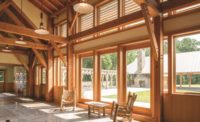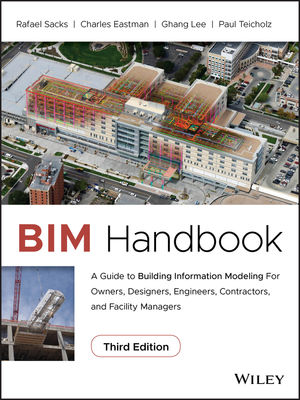Old Meets New










A centuries-old traditional construction method, timber framing uses heavy wood timbers as well as mortise and tenon joinery to create stable structures. A timber frame carries its loads within the wood framework, eliminating the need for interior structure and enabling open floor plans with soaring volumes. Despite today’s availability of standard dimensional lumber, timber framing remains a popular choice for beauty and craftsmanship. Surprisingly, timber framing has also seen a popularity increase for its contributions to high-performance buildings and energy efficiency, particularly when used in combination with Structural Insulated Panels (SIPs).
SIPs are manufactured and marketed by a number of companies, including Murus, Premier, Acme, Insulspan, and Foard, among others. Advance discussion and coordination between general contractor and timber framer can identify the panel system most appropriate for a specific construction project.
History Lesson
Years ago, a timber framed barn or house might have been built of green wood. Trees were felled, the wood dragged out of the forest, timbers squared up as best the craftsmen could manage, and buildings assembled. Traditional wood joinery used pegs and mortise and tenon connections in lieu of mechanical fasteners or metal spikes. The mortise and tenon joint evolved from the lap joint, with the benefit that it can’t fail by coming apart or twisting. The mortise and tenon joint holds the horizontal timber into the vertical timber. As the wood dries over time, it might twist, but the ends actually become tighter to make the joint more stable.
In the 1970s, a small group of timber framers in the U.S. began reviving traditional timber framing techniques and using them in combination with a growing movement toward what would later be called “sustainable” design. The early timber framers, including Hugh J. Lofting, founder of Hugh Lofting Timber Framing in Kennett Square, Pennsylvania, focused on continuous insulation and avoiding thermal breaks to make their buildings tight and energy efficient. The concepts they explored 40 years ago match what the International Passive House Organization, Passive House Institute U.S., and others advocate today.
“Building science wasn’t there yet and Passive House wasn’t formed yet,” explained Lofting. “But builders understood the notion of superinsulation and even though we didn’t realize it at the time, we were starting to develop a strategy for high performance buildings.”
In the 1970s and 1980s, the precursor to the SIP was called a “curtain wall panel” comprised of a similar profile. Instead of insulation sandwiched between sheets of oriented strand board (OSB), as in today’s SIPs, the curtain wall panels were an open-faced sandwich of OSB on the exterior, a central insulation layer, and an interior layer of drywall. The timber framed buildings that incorporated curtain wall panels were called superinsulated because they did not have stud interruptions every 16 inches and had markedly superior energy performance compared to traditional framed buildings with bat insulation.
What’s historically significant is the marriage between timber framing and panel systems. As building science and the understanding of superinsulation evolved, SIPs were born.
Drying and Moving
All timber frames undergo expansion and contraction of the wood as it dries and ongoing movement of the structure. Curtain wall panels offered numerous benefits, but often experienced cracking on the interior drywall layer as the timber naturally moved. The advent and usage of SIPs mitigates the problem; a spacer gap before the drywall layer keeps the two layers separate.
Careful selection of wood species also ensures the natural movement of a timber frame does not have adverse effects on a SIP system.
It takes time or heat to draw moisture out of natural wood. The capillary action within the wood and the moisture in the timber act differently as the heavy timber dries. Allowing the drying process to happen naturally achieves more stable results. Techniques such as kiln and radio frequency drying often only dry the outer inches and result in more wood shrinkage than would occur naturally.
Hugh Lofting Timber Framing recommended Douglas fir as the most stable green, non-dried species of wood for timber framing when using SIPs. While all wood will contort as it dries naturally, Douglas fir does not check or twist as much as other species, meaning a timber framer can achieve more complex geometry and ensure tightness for SIPs. It is quite a bit more stable than oak, which is specified more often for outbuildings or projects without SIPs. By comparison, a piece of oak might take three to four years to naturally dry, while a piece of Douglas fir might be dry in a year or less. Douglas fir offers better design values, shear, and moment of elasticity, requiring smaller section ties.
Connecting Timber and SIPs
Hybrid construction brings two separate systems – timber framing and SIPs – together as parts of an integrated whole.
Timber frame components are designed, engineered, and dry-fit in advance of the timber frame raising day or week. Similarly, SIP panels are assembled, pre-cut, and packed in advance. On the project site, the foundation and first floor deck frame are built according to design and engineering specifications to handle the loads of the timber frame and the SIPs.
On raising day, the timber frame is erected on the deck. It rests inside the perimeter of the house to a dimension that accommodates the SIP installation plus a spacer gap. Finished roof panels get installed on top of the roof members and papered to provide weather protection between the completion of timber framing and the installation of SIPs. In a best-case scenario, SIP installation takes place immediately after timber framing. Roof and wall panels with pre-cut door and window openings are then positioned. The sequence and pre-fabrication of building elements necessitates all geometry be carefully coordinated in advance.
Next comes foaming and splining to ensure an airtight seal around joints between SIPs and at thermal breaks – including doors and windows. It has become commonplace for vendors to offer a blower door test after install of doors and windows to confirm the air-tightness of the envelope. As soon as the SIPs are installed and sealed, the mechanical and finish work can take place on the newly enclosed building.
With the advent of SIPs, a structural timber frame can span larger areas. When combined in a two-part structure with SIPs, a hybrid building can balance the beauty of vaulted ceilings, and a heavy timber aesthetic with a less expensive price tag because fewer heavy timbers are needed.
Sustainable Structures
A hybrid timber frame and SIP enclosed building offers both energy efficiency and renewable resource advantages over traditional frame construction. Timbers from a sustainably managed forest, such as those certified by the Forest Stewardship Council, are a responsible natural wood solution. With an average 20-year renewable resource cycle, engineered wood products such as glulams, cross-laminated timbers (CLT), and parallel strand lumber (PSL) have the added benefit of a more contemporary design aesthetic. In general, wood outperforms concrete and steel for air and water pollution and carbon footprint.
When used in tandem, the two systems create an uninterrupted building envelope while preserving the interior appearance of the timber framing. HVAC and utilities can be placed within service cavities – avoiding contact with insulation – and ensuring consistent R-value and thermal barrier. Proper installation and sealing minimizes air infiltration to keep interior spaces cooler in summer months and warmer in the winter.
Collaboration is Key
Just like in all construction, coordination and teamwork are essential to the success of a timber frame-SIP hybrid project. Advance coordination between the general contractor, timber framer, and SIP manufacturer identifies who does what early in the planning and design process. Hugh Lofting Timber Framing prefers to keep the SIPs within their timber framing scope of work to control exactly the geometric placement and to approve SIP shop drawings. When firms collaborate on the 3D design and work together effectively, the building systems can be integrated efficiently in the field. You can’t get to the SIP install point and be off by a half inch.
Collaboration took the timber framers of the 1970s from re-creating traditional framing to pioneering super insulation. The same spirit of teamwork and innovation will no doubt be the key in continuing advancements in high performance timber frame buildings of the future.
Looking for a reprint of this article?
From high-res PDFs to custom plaques, order your copy today!














